| |
 |
| |
 |
| |
| |
 |
Your reservation must be guaranteed by your credit card information when applying. Tour fees should be paid by credit card or wire transfer once the tour is confirmed with the minimum number of persons for each tour. |
| |
 |
Tour will be confirmed after the payment. |
| |
 |
Tours are subject to change or cancellation if the minimum number of participants is not reached. In the case of cancellation, the travel agency will contact you individually. |
| |
 |
You are encouraged to drop by tour desk of this congress and confirm your tour reservation when you arrive in DCC. |
| |
 |
Cancellation/Refund Policy: Cancellation must be made to Hanjin Travel in writing (yhpark@kaltour.com). The following penalty shall apply ; |
|
| |
| |
<Daily Option Tours> |
| |
* 15 days before the departure date: 100% refund
* 10 days before the departure date: 50% refund
* 6 days before the departure date: 30% refund
* Less than 5days before the departure date: No refund |
| |
|
| |
<Pre & Post-Congress Tours> |
| |
* 30 days before the departure date: 100% refund
* 20 days before the departure date: 50% refund
* 10 days before the departure date: 30% refund
* Less than 9days before the departure date: No refund |
|
| |
| |
 |
For any questions related with the tour in Korea, please contact to the following. |
|
|
| |
| |
 |
| |
| Course |
Date |
Price per person |
| HD-1. Red Clay Trail & Daecheong Dam |
Oct 10/11/12/13/14 |
USD55 |
| HD-2. UNESCO World Heritage City 'GONGJU' |
USD65 |
| HD-3. Exploration of Baekje History & Culture |
USD70 |
| HD-4. Geumsan Ginseng Market |
USD65 |
| FD-1. Korean Tradition City 'JEONJU' |
Oct 10/11/12/13/14 |
USD80 |
| FD-2. Temple Life & Traditional Experience |
USD100 |
| FD-3. Shilla Kingdom, 'GYEONGJU' |
USD130 |
|
| |
 |
| |
 |
| |
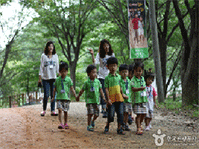 |
 |
Time: 09:00-12:30 |
 |
Price per person: USD55 (Minimum 20 people are necessary for tour to take place |
 |
Price includes a private bus, English-speaking guide, Admissions as per itinerary |
 |
Itinerary: Meet at DCC – Gyejoksan Mountaion Red Clay Trail – Daecheong Dam – Back to DCC |
 |
Description |
|
|
Gyejoksan Mountaion Red Clay Trail is an eco-healing walking trail which can be found on the nation’s first mountain with a barefoot walking theme, Mt. Gyejok. In 2008, it was considered as one of the ‘33 travel destinations to go back to’ by travel journalists. Visitors can walk on red clay and breathe in the fresh aroma of pine trees while enjoying a view of downtown Daejeon from Gyejoksanseong Fortress, which was built during the time of the Three Kingdoms. The trail helps restore the health of the body and soul and gives visitors a therapeutic and unique experience.
Daecheong Dam is a multi-purpose dam consisting of a 72m-tall and 495m-long concrete gravity dam and rock fill dam. It is located where Daejeon and Chungcheongbuk-do meet. The observatory, located at Palgakjeong Service Area, offers a great view of Daecheongho Lake. A variety of fascinating items are displayed in the Water Culture Center on the left bank of Daecheong Dam |
| |
| |
 |
| |
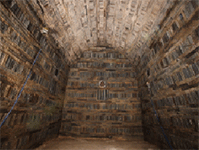 |
 |
Time: 09:00-12:30 |
 |
Price per person: USD65 (Minimum 20 people are necessary for tour to take place |
 |
Price includes a private bus, English-speaking guide, Admissions as per itinerary |
 |
Itinerary: Meet at DCC – Move to Gongju (50min) – Tomb of King Muryeong-wang [UNESCO World Heritage] – Back to DCC |
 |
Description |
|
|
Tomb of King Muryeong-wang (reign 462-523) contains representative relics of the Baekje period (234-678). The Songsan-ri Tombs contain the graves of kings from the period when Baekje's capital was Gongju, and it is believed to contain 10 such graves. Only seven graves have been discovered so far.
The main attraction of Tomb of King Muryeong-wang is the wall painting drawn on the number six tomb – it is the only art of its kind in the world, created from the way the bricks were laid to create the wall. The tomb is shaped like a long tunnel, the top rounded like a dome. There are pictures of fire-breathing dragons on the tomb. Only the parts of the wall where the pictures were to be drawn had earth coated on, and on that earth was drawn Sasindo, the Four Symbols – blue dragon, white tiger, red peacock, and black turtle.
Gongsanseong Fortress consists of a mud castle of 400m long and a stone castle of 2,260m. The circumference and dimension of this fortress are 2,660m long and 210,000㎡ wide. It is located on basin-type hill of 110m MSL with the road linked to the downtown to the south and Geumgang river to the north. It was originally a mud castle, but most parts of it was renovated to a stone castle as it is from the reign of King Seonjo and King Injo in Joseon Dynasty. Gongsanseong Fortress was a capital in Baekje period, but it played certain roles by period in the changes of history as well as in Baekje period. Therefore, relics in each period remained in many places. |
| |
| |
 |
| |
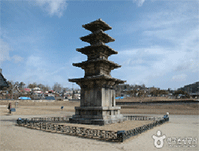 |
 |
Time: 14:00-18:00 |
 |
Price per person: USD70 (Minimum 20 people are necessary for tour to take place |
 |
Price includes a private bus, English-speaking guide, Admissions as per itinerary |
 |
Itinerary: Meet at DCC – Busosanseong Fortress [UNESCO World Heritage] – Jeongnimsaji Five-story Stone Pagoda at Jeongnimsa Temple [UNESCO World Heritage] – Back to DCC |
 |
Description |
|
|
Busosanseong Fortress (Historic Site No. 5) is a mud fortress located on top of Busosan Mountain (alt. 106m) in the northern part of Buyeo. The fortress is estimated by some to have been built around 538 AD (16th year of King Seongwang) to protect Sabi (now Buyeo), which was once the capital of the Baekje Kingdom.
Busosan Mountain was once considered the guardian mountain of Buyeo and is home to historic landmarks from the Baekje Kingdom (18 BC-660 AD). In addition to Busosanseong Fortress, some of the most famous sites on the mountain include Baekhwajeong Pavilion, Sajaru Pavilion, Banwollu Pavilion, Yeongillu Pavilion, Samchungsa Shrine (dedicated to three loyal subjects of the Baekje Kingdom), Gungnyeosa Shrine, Goransa Temple, Gunchangji (military warehouse site), and Suhyeoljugeoji (site of pit houses for the Baekje soldiers). The mountain is also home to Nakhwaam Rock where, according to legend, 3,000 women of the Baekje Kingdom threw themselves into the river below after the collapse of the empire.
Jeongnimsaji Five-story Stone Pagoda at Jeongnimsa Temple: This granite pagoda from the late Baekje period in Buyeo-eup, Buyeo-gun, Chungcheongnam-do has been designated National Treasure No. 9. It is generally known as the 'Baekje 5-story Pagoda.' In the past, it would have been called 'Pyeongjetap.' As one of two extant Baekje pagodas, this stone pagoda itself is a precious artifact and very important in establishing the lineage of Korean stone pagoda patterns. With refined and creative features, it exemplifies the beauty and elegance that were imitated in pagodas built in later periods. |
| |
| |
 |
| |
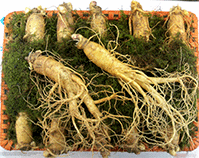 |
 |
Time: 13:00-17:00 |
 |
Price per person: USD70 (Minimum 20 people are necessary for tour to take place |
 |
Price includes a private bus, English-speaking guide, Admissions as per itinerary |
 |
Itinerary: Meet at DCC – Move to Geumsan (50min) – Ginseng Exhibition Hall – Geumsan Ginseng Market – Back to DCCDCC |
 |
Description |
|
|
Geumsan Ginseng Market: Geumsan is widely known as the longest ginseng market in Korea, holding 80% of the nation's ginseng trade. Along with its enormous ginseng industry, Geumsan is also rising as the largest herbal medicine market in the country. The Geumsan Gingseng Market is a traditional market with a long-standing history, offering a variety of health products at its international market. |
| |
| |
 |
| |
 |
| |
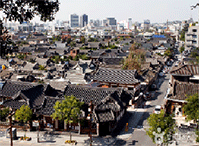 |
 |
Time: 09:00-17:30 |
 |
Price per person: USD80 (Minimum 20 people are necessary for tour to take place |
 |
Price includes a private bus, English-speaking guide, Admissions as per itinerary, Lunch |
 |
Itinerary: Meet at DCC – Move to Jeonju (90min) – Gyeonggijeon Shrine – Jeongdong Catholic Cathedral – Jeonju Hanok Village – Back to DCC |
 |
Description |
|
|
Gyeonggijeon shrine was erected in 1410 and holds the portrait of King Tae-jo, the founder of the Joseon Dynasty. The King and his wife's mortuary tablets are enshrined here at Jogyeong Shrine. Inside Gyeonggijeon, the portraits of King Tae-jo and other successive kings such as Sun-jong, Cheol-jong, Yeong-jo and many others can be found on display.
Jeonju Hanok Village has over 800 traditional Korean 'hanok' houses. This village is especially beautiful for its roof curves. The roof edges being slightly raised to the sky is unique. The food provided is very traditional, which adds to the traditional ambience. At Jeonju Hanok Village, visitors can enjoy traditional Korean life and traditional foods like bibimbap, the most well-known dish from the Jeonju region. |
| |
| |
 |
| |
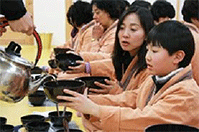 |
 |
Time: 09:30-16:00 |
 |
Price per person: USD100 (Minimum 20 people are necessary for tour to take place |
 |
Price includes a private bus, English-speaking guide, Admissions as per itinerary, Lunch |
 |
Itinerary: Meet at DCC – Move to Magoksa Temple – Temple life Experience (Making smaller Buddhist bracelet, Tea with monk) – Gongju Hanok Village – Back to DCC |
 |
Description |
|
|
Gongju Hanok Village: Gongju is called the 'museum having no roof' as it is full of various historical sites from the Baekje period. Located between the Royal Tomb of King Muryeong and Gongju National Museum, Gongju Hanok Village is comprised of new-style Korean houses combining new elements with the unique ambience of traditional Korean houses with underfloor heating, a pavilion and various hands-on program to learn about the history of Baekje. |
| |
| |
 |
| |
 |
 |
Time: 08:00-18:30 |
 |
Price per person: USD130 (Minimum 20 people are necessary for tour to take place |
 |
Price includes a private bus, English-speaking guide, Admissions as per itinerary, Lunch |
 |
Itinerary: Meet at DCC – Move to Gyeongju(3H) – Bulguksa Temple – Gyeongju National Museum - Daereungwon Tomb Complex (Cheonmachong Tomb) - Cheomseongdae Observatory – Back to DCC |
 |
Description |
|
|
Bulguksa Temple is the representative relic of Gyeongju and was designated as a World Cultural Asset by UNESCO in 1995. The beauty of the temple itself and the artistic touch of the stone relics are known throughout the world.
Gyeongju National Museum rests deep in tradition, with a history of about 90 years. Representing Gyeongju, which used to be the capital of Silla (BC57~AD935), the museum is where you can view the cultural history of Gyeongju district.
Daereungwon Tomb Complex (Cheonmachong Tomb) - Large ancient tombs of kings and noblemen of the Silla Dynasty can be seen around Gyeongju at the Daereungwon Tomb Complex (Cheonmachong Tomb). There are twenty-three large tombs located here; the most famous being Cheonmachong and Hwangnamdaechong. In an excavation of the area in the 1970's, Cheonmachong was discovered with a painting of mounted horse. This painting is the only discovered painting from the Silla Era. You can also view the inside of Cheonmachong. There are 11,526 remains and crowns of the king inside the tomb demonstrating the lavish lifestyle of the king.
Cheomseongdae is the oldest existing astronomical observatory in Asia. Constructed during the reign of Queen Seon-deok (632-647), it was used for observing the stars in order to forecast the weather. This stone structure is a beautiful combination of straight lines and curves, and was designated as National Treasure No.31 on December 20th, 1962. |
| |
| |
 |
| |
| Course |
Date |
Price per person |
| PR-1. Seoul Highlight Tour (3D & 2N) |
Oct 6-8 |
USD350 |
| PR-2. Shilla Kingdom, Gyeongju Tour (3D & 2N) |
Oct 6-8 |
USD445 |
|
| |
| |
 |
| |
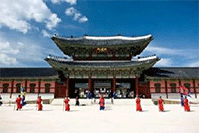 |
 |
Duration: Oct 6-8, 2016 |
 |
Price per person: USD350 (SGL Supplement Charge: USD120)
(Minimum 10 people are necessary for tour to take place)
|
 |
Price includes 4-star Hotel (2 person sharing 1 room), meals as marked on the itinerary, private bus, English-speaking guide, Admissions as per itinerary |
 |
Itinerary: |
|
|
Oct6(Thu) ICN/SEOUL
Hotel C/IN individually
Oct7(Fri) SEOUL: B, L
Meet a guide at hotel lobby (0900) – Gyeongbokgung Palace – Bukchon Hanok Village – Jogyesa Temple – Insadong Antique Alley – N Seoul Tower – Back to hotel (1700)
Oct8(Sat) SEOUL/DAEJEON: B, L
Meet a guide at hotel lobby (0900) – Suwon Hwaseong Fortress [UNESCO World Heritage] – Koraen Folk Village – Move to Daejeon, DCC (1430-1630) |
| |
| |
 |
| |
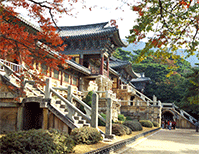 |
 |
Duration: Oct 6-8, 2016 |
 |
Price per person: USD445 (SGL Supplement Charge: USD120)
(Minimum 10 people are necessary for tour to take place) |
 |
Price includes 4-star Hotel (2 person sharing 1 room), meals as marked on the itinerary, private bus, Bullet Train 'KTX' (Seoul → Gyeongju), English-speaking guide, Admissions as per itinerary |
 |
Itinerary: |
|
|
Oct6(Thu) ICN/SEOUL
Hotel C/IN individually
Oct7(Fri) SEOUL/GYEONGJU: B, L
Meet a guide at hotel (0800) – Leave for Gyeongju by KTX (0900-1100) – Gyeongju National Museum – Daereungwon Tomb Complex (Cheonmachong Tomb) – Cheomseongdae Observatory – Anapji Pond – Hotel C/IN (1630)
Oct8(Sat) GYEONGJU/DAEJEON: B, L
Meet a guide at hotel (0830) – Bulguksa Temple [UNESCO World Heritage] – Seokguram Grotto [UNESCO World Heritage] – Move to Daejeon, DCC (1300-1600) |
| |
| |
 |
| |
| Course |
Date |
Price per person |
| PT-1. Seoul Highlight Tour (3D & 2N) |
Oct 15-17 |
USD440 |
| PT-2. Busan & Gyeongju Tour (3D & 2N) |
Oct 15-17 |
USD530 |
|
| |
 |
| |
 |
 |
Duration: Oct 15-17, 2016 |
 |
Price per person: USD440 (SGL Supplement Charge: USD120)
(Minimum 10 people are necessary for tour to take place) |
 |
Price includes 4-star Hotel (2 person sharing 1 room), meals as marked on the itinerary, private bus, Airport limousine bus ticket, English-speaking guide, Admissions as per itinerary |
 |
Itinerary: |
|
|
Oct15(Sat) DAEJEON/SEOUL: L
Meet a guide at DCC (0900) – Korean Folk Village – Gyeongbokgung Palace – Bukchon Hanok Village – Insadong Antique Alley – Hotel C/IN (1800)
Oct16(Sun) SEOUL/DMZ/SEOUL: B, L
Meet a guide at hotel lobby (0800) – DMZ (The 3rd Tunnel, Dora Observatory) – Namdaemun Market – Myeongdong – Back to hotel (1730)
Oct17(Mon) SEOUL/ICN: B
Move to ICN individually (Airport limousine ticket will be provided) |
| |
| |
 |
| |
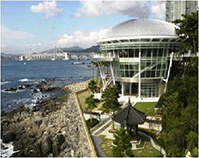 |
 |
Duration: Oct 15-17, 2016 |
 |
Price per person: USD530 (SGL Supplement Charge: USD130)
(Minimum 10 people are necessary for tour to take place) |
 |
Price includes 4-star Hotel (2 person sharing 1 room), meals as marked on the itinerary, private bus, Bullet train 'KTX' (Daejeon → Busan, Gyeongju → Seoul), English-speaking guide, Admissions as per itinerary |
 |
Itinerary: |
|
|
Oct15(Sat) DAEJEON/BUSAN: L
Meet a guide at Daejeon Station (0900) – Leave for Busan by KTX (0930-1110) – Busan Tower – BIFF Square, Nampodong – Gwangandaegyo Bridge, Nurimaru APEC House – Hotel C/IN (1630)
Oct16(Sun) BUSAN/GYEONGJU: B, L
Meet a guide at hotel lobby (0900) – Move to Gyeongju (90min) – Gyeongju National Museum – Daereungwon Tomb Complex (Cheonmachong Tomb) – Cheomseongdae Observatory – Bulguksa Temple [UNESCO World Heritage] – Seokguram Grotto [UNESCO World Heritage] – Hotel C/IN (1730)
Oct17(Mon) GYEONGJU/SEOUL: B
Meet a guide at hotel lobby (0900) – Gyeongju Station – Leave for Seoul by KTX (1019-1231) |
| |


















